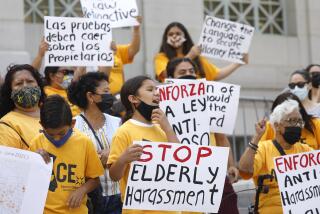Showdown Nears on Adult Entertainment Law : Litigation: A hearing is set on a suit by 22 sex-oriented businesses challenging Los Angeles’ use of a zoning ordinance to control the spread of pornography.
- Share via
The two men walked quickly up Cahuenga Boulevard to a small, nondescript building marked by a small sign reading: “24-hour Video Arcade.” They disappeared through black plastic blinds covering the doorway.
The clerk behind a counter in the dark interior barely looked up as Domingo Sauceda and James Gatlin walked in and one flashed a gold badge.
These men were not vice officers but investigators for the Los Angeles Department of Building and Safety. Their beat, along with unlicensed contractors and recalcitrant landlords, includes operators of X-rated theaters or sex-related businesses that violate city zoning laws.
Like players in a long-running game, the clerk chewed gum as the inspectors surveyed the store’s adult-oriented inventory.
The men say that they do little more than spot-check the city’s adult businesses. More aggressive enforcement of a 5-year-old ordinance to control the spread of pornography in Los Angeles is on hold, awaiting the outcome of a federal lawsuit challenging the city’s law.
A 1986 City Council ordinance made it illegal for an adult entertainment businesses to operate within 500 feet of a residential area, church, school or public park, or within 1,000 feet of a similar business. The deadline for all such businesses to move or shut down expired March 6.
But only a handful of zoning prosecutions have been undertaken as the city defends its ordinance against a suit brought by 22 adult-oriented businesses. The zoning regulations are so restrictive, the businesses charge, that operators will be forced out of business and denied their constitutional right to free speech.
U.S. District Judge Richard A. Gadbois Jr. has scheduled a hearing June 17 to decide on a request by the businesses for an injunction against enforcement of the ordinance.
The ruling, in Topanga Press Inc. vs. City of Los Angeles, will play an important part in how the city deals with its massage parlors, adult bookstores, arcades, cabarets and theaters, which are variously estimated at 60 to 102.
“If the decision declares the entire ordinance unconstitutional then we can’t enforce it against anybody,” said Marcia Gonzales-Kimbrough, deputy city attorney in charge of special enforcement.
“If we lose, this town will be without adult entertainment businesses across the board,” said Randall Garrou, a Beverly Hills attorney representing the businesses in the suit.
As the two sides square off, the central issue is where, and whether, the businesses could reopen if they are found in violation.
“One could more easily open a nuclear waste dump in Los Angeles,” said John Weston, a Beverly Hills attorney and longtime specialist in adult entertainment law, who represents the businesses.
Weston says he thinks that Los Angeles’ law is unusually severe. “You have strip zoning here. You’d be hard-pressed to find an area of the city that isn’t 500 feet from a residential zone.” A land use study financed by the businesses found that less than 2.46% of city land was actually available to adult entertainment businesses, he added, “and some of that is under water.”
Deputy City Atty. L. Wayne Mooney, defending the city in the suit, said sex-related businesses can still operate within the zoning requirements. “The evidence will show there’s more than enough space to accommodate the existing adult businesses when they move outside the restrictions,” he said.
There is more land than the owners say, Mooney contended. But even if the 2.46% figure is correct, he added, “that is more than 7,000 acres. Imagine how many 50-by-140-foot lots that is. You’ve got oodles of locations.”
The dispute began five years ago when the council amended an adult entertainment zoning ordinance passed in 1978. Distance requirements existed before 1986 but only applied to new businesses. The council voted to apply the distance requirements to existing businesses. They had to move or close by March, 1988, or get extensions until March, 1991.
“Just about everybody” got extensions, James Carney, chief inspector for the Building and Safety Department said. He estimated that about 100 were operating in March, 1988, and that only 12 closed up voluntarily.
The Topanga Press case, involving one bookstore, was filed in 1988, and then was joined by several others early this year.
The actual number of adult businesses operating in the city is unclear. Garrou said city records obtained by his firm indicate that there are 102, only five of which meet the zoning restrictions.
Mooney declined to supply a figure, saying that it was an issue in the case. Some of the 22 businesses in the suit contend that the ordinance is too vague in the way it defines adult operations and do not even concede that they are “adult.”
The city attorney’s office has prosecuted six businesses in the last two years for violating the ordinance, according to Gonzales-Kimbrough. Owners of two massage parlors pleaded guilty and closed. The cases of two bookstores are still in court. Operators of two other businesses were convicted at a Municipal Court jury trial--including Hollywood Video, the adult bookstore that inspectors Sauceda and Gatlin were checking, and a man who gave sex parties at his West Los Angeles home.
Zoning ordinances that regulate locations of adult entertainment businesses have become increasingly common in the last two decades--from Boston to Dallas to Seattle.
In Southern California, zoning regulations in various forms can be found in San Diego, Long Beach, Santa Barbara, and San Bernardino County, as well as Westminster and Garden Grove in Orange County. Los Angeles County requires 1,000 feet between adult businesses in unincorporated areas.
“It is a very common tool of land use regulation,” said Mike Bouvier, director of planning and building for Westminster. “Distance is an effective buffer for businesses which together can become so concentrated that you have a problem greater than each of its parts.”
Prosecution is also easier under zoning laws, officials say. Unlike prosecutions for lewd conduct or prostitution taking place at adult businesses, often involving undercover vice investigations by police, officials enforcing zoning violations can just point to street maps.
“It’s already implicit in the ordinance that the mere existence of an adult entertainment business has a negative impact on certain communities,” Gonzales-Kimbrough said. “Whereas in a red-light abatement we have to show criminal activity. . . . (Zoning laws determine that) a massage parlor, regardless whether there is prostitution going on, should be located where it cannot negatively impact the community.”
The legal battle in Los Angeles is the latest of several waged since Detroit, believed to be the first to adopt such an ordinance in 1972, was challenged by an adult theater chain for restricting its right to free speech.
But in 1976, Detroit’s ordinance, which said adult entertainment businesses could not locate less than 1,000 feet from any two other sex-related business establishments, was upheld in a landmark U.S. Supreme Court decision.
The high court’s ruling said a municipality could regulate the location of adult enterprises to protect against the “secondary impact” of crime or blight on local neighborhoods. The court said that the businesses could move to other locations in Detroit and that the owners’ First Amendment rights were not violated.
Other rulings followed, including a 1986 decision involving Renton, Wash., near Seattle. Two adult theater owners contended that their rights were violated because none of the land that the city allowed for adult use was “commercially viable.” But the court ruled that as long as land was available, governments did not have to ensure that the new sites would be considered choice locations.
Interpreting the Los Angeles ordinance has resulted in a variety of disputes. One involved how to measure the distance between an adult bookstore and a nearby apartment complex. Is it the owner’s property line--which violated the 500-foot rule--or the store building’s wall, which did not? The city Board of Zoning Appeals ruled that the measurement should be made from the wall.
Another involved defining “adult oriented.” How much sexually oriented material in a store made it an adult entertainment business? The city considers an establishment an adult business if more than 50% of the merchandise for sale is in that category. So inspectors such as Sauceda and Gatlin end up spending hours counting the “sex aids” and X-rated videos, books and magazines.
“A lot of times they’ll bring in hundreds of old National Geographics,” Gatlin said, “and then claim their business is not predominantly adult. One place I know brought in sunglasses, put thousands of pairs on display.”
At Hollywood Video, for example, the two inspectors ignored shelves full of X-rated magazines, inflatable dolls and bondage videos and went to the back of the store, where old issues of Scientific American and Dark Room Photography were stacked in piles. Children’s cartoon videos, such as “Casper the Ghost” and “Daffy Duck” were also on display.
Laurence Buzin was convicted in April for operating Hollywood Video within 500 feet of an apartment house and within 1,000 feet of another adult bookstore. Buzin did not fight the zoning ordinance but said he was not the store’s true owner. A jury disagreed, and Municipal Judge Carol Boas Goodson fined him $2,300 and sentenced him to probation.
To remain open legally in that location, the store would have to be selling mostly non-adult material. But Sauceda and Gatlin, a month later, didn’t think much had changed.
They stared knowingly at the boxes of old magazines, for they had counted them before. “Last time we counted everything, down to individual condoms, it came out 52% adult,” Gatlin said with a sigh. “If I were looking for the October, 1990, Scientific American, this is the place I’d come.”
More to Read
Sign up for Essential California
The most important California stories and recommendations in your inbox every morning.
You may occasionally receive promotional content from the Los Angeles Times.









